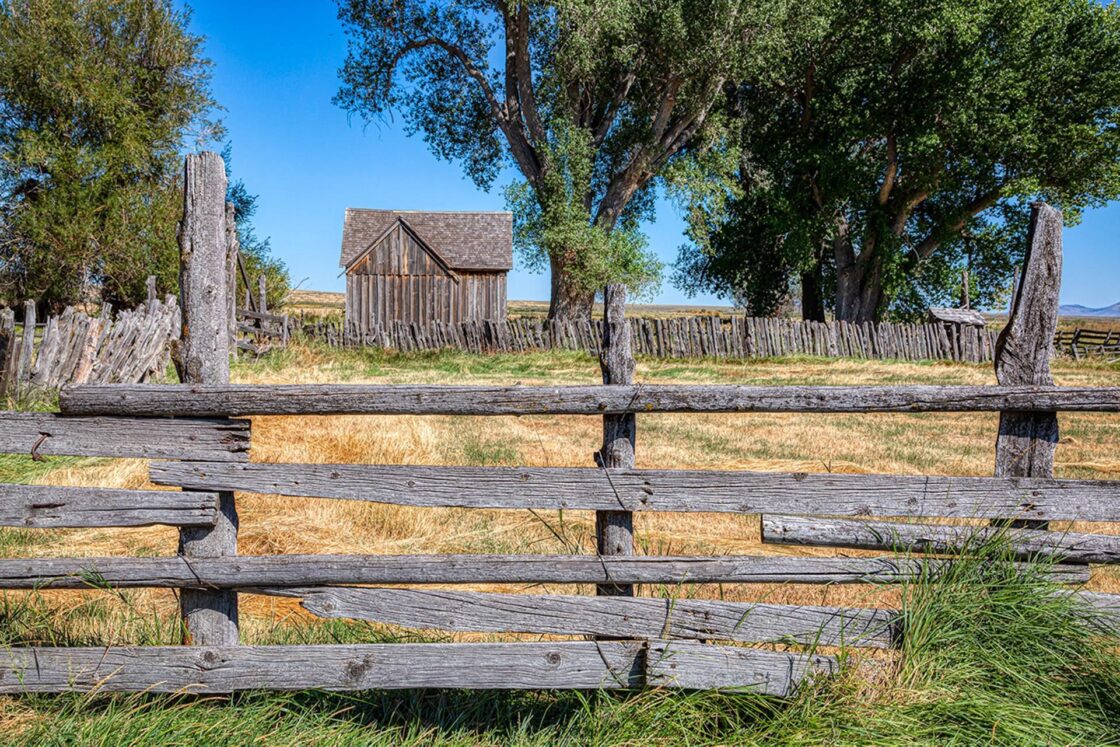Malheur Refuge was created in 1908 in direct response to a widespread practice at the time: the decimation of breeding birds for their feathers.

The Making of Malheur Refuge
In the late 1800s, “plume hunters” eager to harvest colorful and elaborate breeding plumage wiped out entire colonies of waterbirds, killing and plucking the adults and leaving their eggs and chicks to perish. The plumes were considered high fashion in the millinery trade, adorning hats and other couture articles of the era.
In those days, an ounce of breeding feathers was worth more than an ounce of gold; it’s no surprise that plume hunters sought to “make a killing” by targeting the many thousands of birds breeding at Malheur Lake.
One of the most persecuted species was the great egret. In the decades leading up to the establishment of Malheur Refuge, thousands of great egrets nested in colonies along the lake shore. By the time wildlife photographers William L. Finley and Herman T. Bohlman visited Malheur Lake in 1908, nearly all of these birds had been killed by plume hunters. The photographers failed to find a single pair of egrets after weeks of searching.
Dismayed by what they saw, Finley and Bohlman petitioned to stop the slaughter of birds at Malheur Lake and its environs. Their photographs and testimony caught the attention of President Theodore Roosevelt, who quickly moved to formally protect these critical breeding areas from further depredation.
On August 18, 1908, President Roosevelt signed an executive order establishing the “Lake Malheur Reservation” in southeast Oregon. The reservation set aside more than 80,000 acres of land surrounding Mud, Harney and Malheur Lakes “as a preserve and breeding ground for native birds.” It was the 19th Wildlife Refuge established by President Roosevelt; he would establish 51 in all during his presidency.
This was the third Refuge in Oregon at the time, and one of only six Refuges west of the Mississippi. In 1935 the reserve became known as Malheur Migratory Bird Refuge, and would eventually grow to encompass 187,756 acres.
Refuge Historical Points of Interest
- Double O Ranch
- P Ranch
- Sodhouse Ranch


Double O Ranch
In 1875 the partnership of Amos W. Riley, Colonel James A. Hardin and John Taylor established a ranch on the west side of Harney Lake. Already owners of extensive holdings in Nevada, they claimed the springs at today’s Double-O Ranch, as well as the area around the outlet of Silver Creek at Harney Lake, and land bordering Silver Creek as part of their Oregon ranch. Centered on the productive springs of the Warm Springs Valley, cattle from the ranch had access to plentiful native grasses and reliable water.
The Double-O Ranch was seriously impacted in 1878 during a raid led by Bannock Indians. The ranch had been abandoned as the crew fled to Fort Harney for protection. All of the buildings at the ranch were destroyed and most of the ranch’s cattle and horses were herded west to the Wagontire area where they were slaughtered. Reconstruction began immediately and the ranch recovered to become the third largest ranch in Harney County.
In 1890 Taylor dropped out as a partner and Hardin sold his half interest in 1892 to Riley. Beginning with a mere 1,200 acres the ranch grew to over 8,600 acres before being sold to William Hanley in 1903. Hanley combined the Double-O property with his larger Bell-A Ranch holdings, creating the second largest cattle operation in Harney County.
In 1909 irrigation ditches were constructed from the springs to various areas of the ranch. With the addition of irrigation water the ranch grew ample amounts of winter feed for ranch livestock and for sale to neighboring ranches. Many of these irrigation ditches are still used today to move spring water around the Double-O area.
Hanley is often credited with bringing the railroad to Harney County. His efforts in 1911 to bring the railroad from the Columbia River to Bend put pressure on the Union Pacific Railroad to extend a rail line from Ontario to Crane. This improved Hanley’s ability to move his cattle to market in the fall and to purchase new cattle in the spring. Hanley easily entered into a “feeder operation” and greatly increased his wealth and influence. In 1912 Hanley ran successfully for the U.S. Senate.
When Hanley died in 1933 his wife, Clara, continued operation of the ranch. The deepening nationwide depression and the ongoing drought forced reductions in the number of cattle the land could support. Mrs. Hanley finally sold 14,751 acres at the Double-O to the U.S. Government in 1941 for $116,143 and the land was added to the Refuge.


P Ranch
P Ranch, located near the present-day community of Frenchglen, has been owned by the Refuge since 1935, when it was purchased from the Eastern Oregon Livestock Company. The ranch is best known as the headquarters of the vast ranching empire managed by John William “Peter” French for San Francisco businessman Dr. Hugh Glenn.
It took ten years after passage of the Homestead Act for settlers to arrive in the Blitzen Valley. Dr. Glenn took advantage of the 1862 Act to begin building a vast cattle empire in southeastern Oregon. In 1872 he sent his ranch boss, Peter French, with 1,200 head of cattle, six vaqueros and a cook to Oregon. French used the Homestead Act to claim 160 acres at the south end of the Blitzen Valley for his boss. Using this as headquarters for the ranch he managed for Glenn, French continued to acquire land over the next 25 years using not only the Homestead Act, but also the Swamp Land and Desert Acts. French eventually managed a ranch that encompassed over 140,000 acres including the Blitzen, Diamond and Catlow Valleys.
Under each of the Acts, applicants were required to make “improvements” to the land for agricultural purposes; this could include improvements for livestock grazing. As a result of these stipulations the Blitzen Valley and surrounding areas underwent a transformation from the more natural conditions attributed to pre-European contact to the highly altered landscape of today. Roads were constructed; water was directed into ditches to drain or irrigate areas; streams were impounded to control the direction and velocity of flow; meadows were hayed; and uplands were grazed.
After French’s death in 1897, the ranch was managed as the French-Glenn Livestock Company until debts forced the sale of land in 1907 to Henry L. Corbett and C.E.S. Wood of Portland. They formed the Blitzen Valley Land Company under the management of area rancher William Hanley. The goal of the company was to return the property to a successful working ranch. To accomplish this, the company needed to improve water distribution in the valley. Between 1907 and 1913 the company channelized 17 ½ miles of the Donner und Blitzen River to improve drainage of adjacent wetlands. They also authorized the construction of eight miles of the Busse Ditch and four miles of the Stubblefield Ditch to improve distribution of water in the north end of the valley.
In 1916 the company was reorganized as the Eastern Oregon Livestock Company (EOLC). Louis Swift of the Swift Packing Company of Chicago purchased 46 percent of the company under this reorganization. The construction of a Union Pacific rail line from Ontario to Crane in 1916 made shipping livestock to market easier. Swift was interested in the thousands of feral pigs in the Blitzen Valley, as well as the cattle raised on the ranch. Under his direction the pigs were rounded up and herded to Crane where they were loaded on stock cars and transported to his Chicago meat packing plant.
In 1920 the company established the Blitzen River Reclamation District. Tracts of 160 acres were laid out and leased in a sharecropping arrangement. Several dairies were established on these tracts and the EOLC used the railroad at Crane as a venue for shipping dairy products out of the county. The EOLC also established a hotel and store at Frenchglen in the mid-1920’s. In 1918 an irrigation ditch was constructed from Page Springs along the west side of the valley to what is now known as Krumbo Lane. In 1928 Swift bought out Corbett’s controlling shares in the company and owned the ranch until 1935 when he sold it to the U.S. Government.


Sodhouse Ranch
Located along the south shore of Malheur Lake, Sodhouse Ranch is the northern terminus of what had been one of the largest cattle ranches in the U.S. during the late 1800’s: the French-Glenn Livestock Company, owned by Dr. Hugh Glenn of California and managed by John William “Peter” French.
In 1877, Peter French expanded the French-Glenn Livestock Company holdings to the south side of Malheur Lake. He established a sub-headquarters at Sodhouse Ranch to maintain control of land at the north end of the ranch. (The name “Sodhouse Ranch” originally referred to a rudimentary house made of sod that ranchers built along the Malheur Lake’s south shore in the 1880s. This house served as a landmark for residents and its name was used to describe the area from that point onward.)
Continued expansion of the ranch eventually created conflicts between homesteaders on Malheur Lake and the ranch. As the ranch expanded northward in the 1880’s, more and more water was diverted from the Donner und Blitzen River to irrigate hay meadows and water was also being diverted along the Silvies River. This resulted in diminishing quantities of water reaching Malheur Lake and a corresponding change in the high meander line of the lake. The ranch claimed ownership of all land up to the high meander line, but with diminished lake levels the area between the former high meander line and the actual lake was undefined. Settlers claimed it was new public domain land available for settlement, but the ranch claimed it was just an extension of their original riparian claim. The State of Oregon claimed that the land belonged to them under the provisions of the Swamp Land Act.
By the late 1880’s settlers were building shacks on any available high point on this newly exposed land. They farmed and grazed the adjacent ground until water levels became too high, but eventually water levels would decrease and they were in business again. Eventually French was pressured into filing lawsuits against “squatters” on the south side of the lake by Glenn’s heirs. While the lawsuits worked their way through the court system, the settlers became increasingly hostile towards French and the ranch holdings. Fences were cut and stores of winter hay were burned by angry settlers. Eventually these hostilities culminated in the death of Peter French. On December 26, 1897 French was shot by Ed Olivier, one of the homesteaders, while he was moving cattle near Sod House Ranch. Olivier was eventually acquitted of murder.
French’s demise did not end the conflict. Settler Sarah Marshall won her case against the French-Glenn Livestock Company, when appeals in the case reached the U.S. Supreme Court. The Court ruled in 1901 that the lands were not part of the Company’s original claim based on their riparian rights, and awarded the property to Marshall as a claim on the public domain. This decision by the Court also gave the President a legal basis for declaring unclaimed land around the lakes federal property, thus providing an opportunity for establishment of the refuge seven years later.
Today, Sodhouse Ranch offers a historical perspective of pre-refuge times. Its eight remaining buildings were added to the National Register of Historic Places in 1979 because they represent a largely intact ranch of its era, and because Peter French was a famous cattle baron in his time.


Be a Malheur Refuge Advocate.
You can become a Malheur Refuge champion by joining the Friends of Malheur and together we can advocate for a secure and more prosperous future for Malheur National Wildlife Refuge and our national wildlife refuge system.


